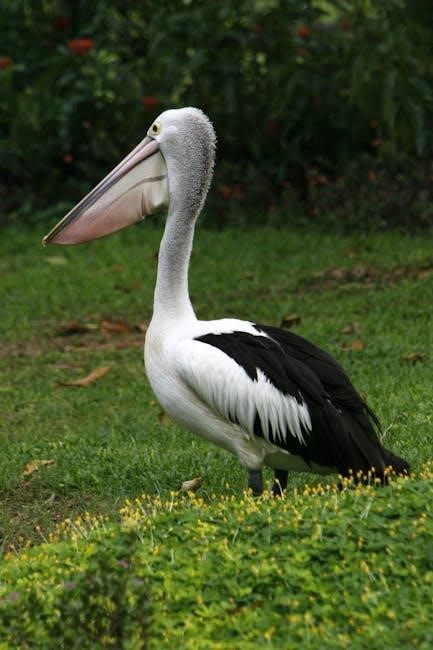The Field Guide to Birds of Australia is a comprehensive guide
featuring detailed information and illustrations of Australian bird species clearly.
Overview of the Guide
The Field Guide to Birds of Australia provides a thorough overview of the country’s bird species, with a focus on identification and classification. The guide is divided into sections, each covering a specific aspect of Australian birdlife. The book’s contents are carefully organized to facilitate easy navigation and quick reference. A detailed table of contents and indexes are included to help readers locate specific information. The! guide’s preface outlines the scope and purpose of the book, while the introduction sets the context for the importance of birdwatching in Australia. Overall, the guide offers a comprehensive and authoritative resource for anyone interested in Australian birds, from beginners to experienced ornithologists, with its clear and concise writing style making it accessible to a wide range of readers. The guide is a valuable resource for bird enthusiasts and researchers alike, providing a wealth of information on Australian bird species.
Importance of the Guide
The Field Guide to Birds of Australia holds significant importance for conservation efforts and research initiatives. By providing accurate and up-to-date information on Australian bird species, the guide enables readers to contribute to citizen science projects and inform conservation decisions. The guide’s authority and credibility also make it an essential resource for educators and students, facilitating learning and teaching about Australian birdlife. Furthermore, the guide’s comprehensive coverage of bird species and their habitats raises awareness about the importance of preserving Australia’s unique biodiversity. As a trusted reference, the guide supports the development of environmental policies and management plans, ultimately contributing to the protection of Australian bird species and their ecosystems. The guide’s impact extends beyond the birdwatching community, influencing a broader understanding and appreciation of Australia’s natural heritage. The guide is a vital tool for promoting environmental sustainability.

Features of the Guide
The guide includes various features such as book recommendations and author interviews clearly explained.
Illustrations and Plates
The guide contains 132 superb full-colour plates showing all Australian bird species, which are essential for identification and study. These plates are accompanied by over 900 black and white line illustrations, providing further detail and clarity. The illustrations and plates are the work of skilled artists, including Frank Knight, and are renowned for their accuracy and beauty. The combination of full-colour and black and white illustrations allows for a comprehensive and detailed representation of the bird species. The plates and illustrations are carefully arranged and labelled, making it easy for users to navigate and find the information they need. The guide’s illustrations and plates are a key feature, setting it apart from other field guides and making it an invaluable resource for birdwatchers and researchers alike, with a focus on visual identification. The quality of the illustrations is exceptional, with attention to detail and accuracy.
Identification and Distribution
The guide provides key points of identification using the latest classification system, allowing users to accurately identify bird species. Distribution maps are included for all species, showing their range and habitat. The maps are based on recent bird atlas data, ensuring that the information is up-to-date and accurate. The guide also includes information on the latest taxonomy, reflecting the most current understanding of Australian bird species. The identification and distribution information is presented in a clear and concise manner, making it easy for users to understand and apply. The guide’s focus on identification and distribution makes it an essential tool for birdwatchers and researchers, enabling them to locate and identify bird species in their natural habitats. The combination of identification keys and distribution maps provides a comprehensive understanding of Australian bird species and their habitats. This information is crucial for conservation efforts and bird research.
Additional Information
The guide includes a vagrant bird bulletin, which provides information on rare and unusual bird sightings in Australia. A core library list is also included, recommending further reading and resources for bird enthusiasts. The guide features easy-to-use indexes, allowing users to quickly locate specific species and information. The additional information section also includes a list of references and further reading, providing a wealth of resources for those wishing to learn more about Australian bird species. The guide’s appendix includes a glossary of terms and a list of abbreviations, making it a valuable resource for both beginners and experienced birdwatchers. The additional information provided in the guide enhances its usefulness and value, making it a comprehensive and authoritative reference on Australian bird species. The guide’s attention to detail and commitment to providing accurate and up-to-date information make it an essential tool for anyone interested in Australian birds.
Updates and Revisions
The Field Guide to the Birds of Australia has undergone several updates and revisions since its first publication in 1980. The guide has been revised to reflect changes in bird classification and taxonomy, ensuring that the information provided is accurate and up-to-date. The latest edition includes new species and updated distribution maps, making it a valuable resource for birdwatchers and researchers. The revisions have also improved the guide’s user-friendliness, with re-ordered species entries and expanded indexes. The updates and revisions have been made in response to new research and data, and the guide continues to be a trusted and authoritative reference on Australian bird species. The guide’s commitment to providing accurate and up-to-date information has made it a leading resource in the field of Australian ornithology, with each new edition building on the success of the previous one.

Species Information
The guide provides detailed species information and data clearly presented.
Species Entries

The species entries in the guide are comprehensive and detailed, providing readers with a wealth of information on each species.
The entries are organized in a logical and easy-to-use format, making it simple for readers to find the information they need.
Each entry includes a range of details, such as the species’ distribution, habits, and characteristics, as well as any relevant conservation status information.
The guide also includes a range of illustrations and photographs to help readers identify and learn more about each species.
The species entries are written in a clear and concise manner, making the guide accessible to readers of all levels of expertise.
The guide’s detailed species entries make it an essential resource for anyone interested in learning more about the birds of Australia.
The entries are carefully researched and written by experts in the field, ensuring that the information is accurate and up-to-date.
Overall, the species entries in the guide are a valuable resource for anyone interested in birds.
Field Marks and Identification
The guide provides detailed information on field marks and identification, helping readers to distinguish between similar species.
Key points of identification are highlighted, including plumage, beak shape, and leg color, making it easier to identify birds in the field.
The guide also includes information on behavioral characteristics, such as flight patterns and foraging habits, which can be useful for identification.
The field marks and identification sections are accompanied by detailed illustrations and photographs, showing the key characteristics of each species.
This information is essential for birders of all levels, from beginners to experienced observers, and helps to ensure accurate identification.
The guide’s focus on field marks and identification makes it a valuable resource for anyone interested in birds, and helps to promote a greater understanding and appreciation of Australian birdlife.
The information is presented in a clear and concise manner, making it easy to use in the field.
Nesting Habits and Voice Characteristics
The guide includes detailed information on nesting habits, such as nest structure and location, and voice characteristics, including calls and songs.
This information helps readers to better understand the behavior and ecology of Australian bird species.
The nesting habits section provides insight into the breeding biology of each species, including the type of nest, incubation period, and clutch size.
The voice characteristics section includes descriptions of the different calls and songs made by each species, which can be an important aid to identification.
The guide’s coverage of nesting habits and voice characteristics makes it a valuable resource for anyone interested in learning more about Australian birds.
The information is presented in a clear and concise manner, making it easy to use and understand.

The guide’s attention to detail on these topics is impressive, with a wealth of information on each species.
The guide is a valuable resource for birders and researchers in Australia clearly and effectively.
Value of the Guide
The Field Guide to Birds of Australia is a highly valued resource for both amateur and professional birders, providing a comprehensive and authoritative reference for identifying and understanding Australian bird species.
The guide’s value lies in its ability to bring together a vast amount of information on bird identification, distribution, and behavior, making it an essential tool for anyone interested in Australian birds.
The guide’s popularity and reputation are a testament to its value, with many considering it a must-have for any birding enthusiast or researcher in Australia, and its impact on the field of ornithology is significant.
Overall, the guide is a valuable asset for anyone looking to learn more about Australian birds and their habitats, and its value will continue to be recognized for years to come, making it a worthwhile investment for anyone interested in birding.
